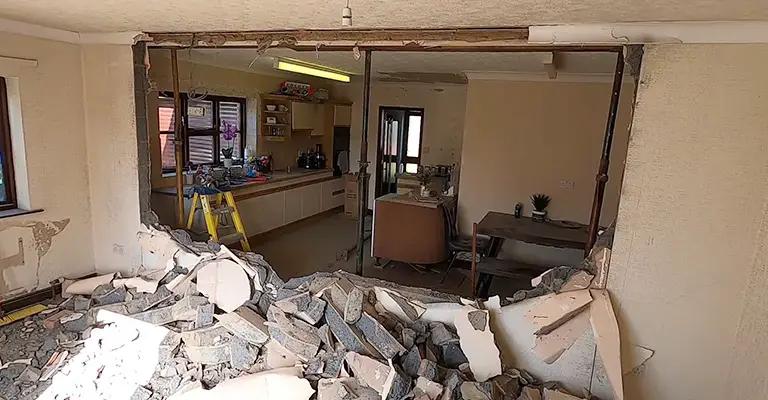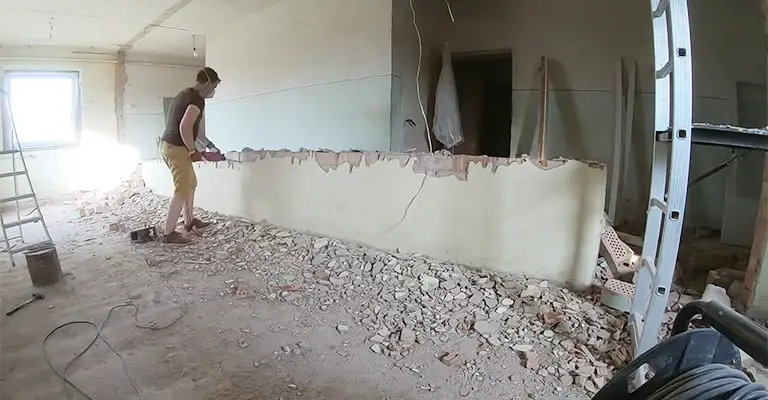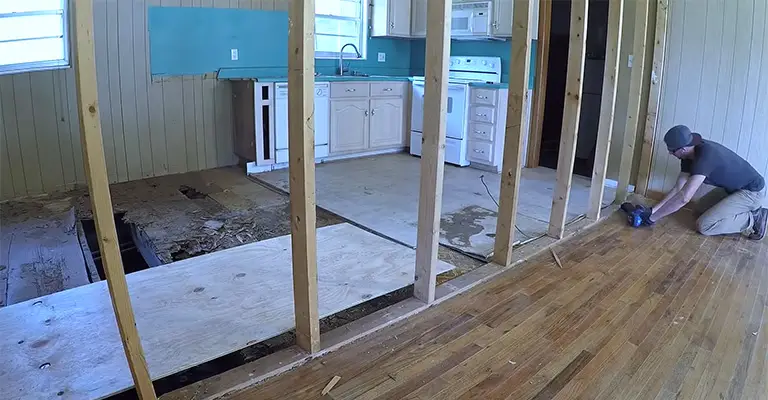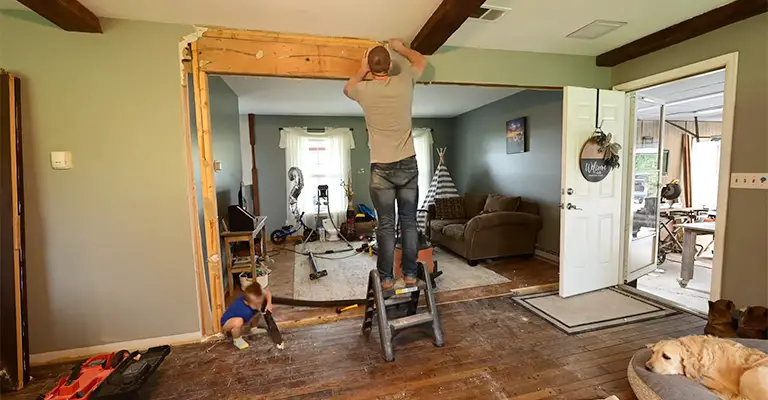As the heart of a home, the kitchen is often where family and friends gather to cook, share meals, and create lasting memories.
In many houses, however, the kitchen and dining room are separate spaces, creating a sense of division and limiting interaction between occupants.
Knocking down the wall that separates these areas can transform your living space, fostering an open and inviting environment that promotes togetherness and enhances functionality.
Before embarking on any home renovation project, it is crucial to consider the associated costs.
For a non-load-bearing wall, the cost will range from $400 to $1,500; for a load-bearing wall, it will range from $1,800 to $14,000.
This expense of removing a wall between the kitchen and dining room can vary depending on several factors, including the complexity of the project, structural considerations, materials needed, and regional pricing disparities.
Understanding the financial implications of such an endeavor will help you plan and budget effectively, ensuring that your vision aligns with your financial means.
It is also essential to consider the design of your home, as multi-story homes tend to cost more if an entire wall is removed from the bottom level.
If you want to open your kitchen, open one of your bedrooms, or add another entrance to your living room, you’ll have to hire a professional.
Cost To Knock Down A Load-Bearing Wall [2024 Data]

A load-bearing wall, which supports everything above and below it, will be more expensive to remove. If you are removing a load-bearing wall in a single-story home, it will cost $1,200 to $3,000 to do so.
Cost and potential complications also increase when it comes to multi-level homes. If you own a multi-story house, expect to pay between $3,200 and $10,000 for wall excavation.
Load-bearing walls are typically located above metal or multi-board wood beams in a basement, directly above or below load-bearing walls in other rooms, directly above or below knee walls in the attic, or directly below or above flooring joists. In addition, every exterior wall is load-bearing.
Cost To Tear Down A Non-Load-Bearing Wall

In general, removing a non-load-bearing wall costs around $300 to $1,000.
A non-load-bearing wall can be difficult to distinguish from a load-bearing wall because both can appear the same from the exterior.
There are, however, different levels of support available with each. Depending on the home’s architectural plans, non-load-bearing walls are indicated.
It is common for non-load-bearing partitions not to have any walls, posts, or other supports below or above them.
The rule does not necessarily apply to all walls, so you should hire a professional inspector to check its load-bearing capacity.
Cost To Knock Down A Wall Yourself
As a general rule, we recommend that you avoid doing DIY wall removal since the whole process can cause serious injury and structural damage.
In exchange, the contractor will save a little bit of time, which will be reflected in a lower cost. Remove any obvious obstacles before they arrive and clean and prep the area.
It would also be helpful to put on your DIY hat after the job is done to save a few dollars. Whether you choose to repaint the room or lay wallpaper, do so at your discretion.
However, you will have to hire multiple tradespeople to handle plumbing, wiring, and drywall issues.
Unforeseen Costs

Many factors influence a load-bearing wall’s removal costs. It’s because you can’t see what’s inside a wall until it’s opened. Depending on the solution, some costs will be obvious, whereas others won’t be apparent at all.
It may be necessary to incur additional costs for the following:
- A mold or asbestos removal will cost you between $1,000 and $3,000.
- Electrical wire rerouting: about $500
- Routing of gas lines and/or plumbing: $700-900
- A brick or cinder block wall will need to be demolished and removed for approximately $500
- Painting or wallpaper touch-up: 43 dollars
- For ceiling retexturing or adjoining wall retexturing, a fee of 45 is charged (35 square feet).
- It costs $1,100 to move cooling ducts.
The added expense of removing a load-bearing wall can outweigh any aesthetic benefit it might add to your home.
You have to patch the floor, ceiling, and adjacent walls once a wall is demolished, whether you are doing it yourself or hiring a local contractor.
It’s always a good idea to budget a little more to save money on remodeling.
What Factors Influence the Cost to Knock Down a Wall?

Due to the differences in size, difficulty level, and scope, the renovation cost will vary depending on the individual issue.
In addition to the size and design of your house, the amount of labor involved, and any replacement materials needed, wall removal costs can be highly variable.
Additionally, many pipes, wires, and structural support beams are located behind the average wall. In all of these cases, the cost estimate is affected.
Including the fee for a structural engineer to assess your specific needs will help you get an accurate quote.
Wallpaper Removal and Replacement
It may be necessary for you to hire someone to replace the wallpaper to match the adjoining rooms. Wallpaper installation costs generally range from $400 to 750 dollars.
A professional wallpaper removal service will charge $400 to $1,100, depending on the size and type of wallpaper impacted by the wall removal.
Electrical Wiring
In addition, electrical wiring is often hidden behind walls. Rerouting these wires requires the services of an electrician near you.
It may vary depending on the complexity of the job, but electricians typically charge between $50 and $100 an hour.
If you hire an electrician for an easy project, they will usually charge you a minimum of one to two hours.
Depending on the situation, it may be necessary to increase the rate if the electrician discovers anything unexpected, such as outdated or substandard wiring.
Plumbing
The replacement or removal of some pipes behind walls will likely need to be carried out by a professional plumber.
While exact rates will vary depending on the scope of the work and the number of pipes that need to be serviced, hiring a local plumber will cost anywhere from $45 to $200 per hour, plus materials.
Support Beams
A load-bearing wall can’t be knocked down without replacing it with some kind of alternative support.
You are lucky because the same structural engineer who knocked down your wall will find you a contractor to install a support beam. The high cost of steel support beams, at $1,300 to $5,000, despite their durability, is indicative of their durability.
The most cost-effective option is laminated veneer lumber (LVL) beams, which range in price from $55 to $400, with additional labor costs of $200 to $400.
It is extremely important that this job be outsourced to a competent professional with plenty of experience.
It is possible to create structural instability if support beams are not installed properly. This can cause unlevel floors, cracked ceilings, sticking doors, and, worst of all, total structure collapse.
Final Words
Excavating and removing walls is a significant investment for homeowners, regardless of if the investment pays off.
Furthermore, dealing with a home’s structural integrity comes with inherent risk. Choose a reputable technician to ensure everything goes smoothly.
Check to make sure the contractor has a license, adequate insurance, and the necessary experience to do the job safely. Additionally, you can ask previous contractor clients for advice via local online forums.







